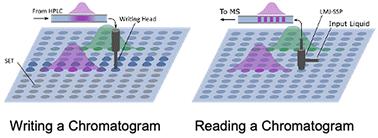Our official English website, www.x-mol.net, welcomes your
feedback! (Note: you will need to create a separate account there.)
Storing liquid chromatographic separations on surface energy traps: decoupling the LC and the mass spectrometer
Analyst ( IF 3.6 ) Pub Date : 2024-09-26 , DOI: 10.1039/d4an00828f Timothy T. Salomons, David Simon, Richard Oleschuk
Analyst ( IF 3.6 ) Pub Date : 2024-09-26 , DOI: 10.1039/d4an00828f Timothy T. Salomons, David Simon, Richard Oleschuk

|
We report a micro-fractionation device for high performance liquid chromatography-mass spectrometry to archive chromatographic separations on an array of optimized surface energy traps (SETs). The method has the potential to significantly alter nanoflow LC-MS workflow, decoupling separation and analysis. The wetting characteristics of the SETs cause the HPLC eluent stream to spontaneously split into droplet microfractions. The droplet mirofractions are then dried down to enable facile storage and transport of the archived separation. Discontinuously dewetting array parameters were explored to maximize array volume and resolution using a combination of SET design, shape, size, and spacing. Mass spectrometry analysis is performed utilizing a liquid micro-junction surface sampling probe to extract dried analytes from the surface of the SETs followed by electrospray ionisation. A reverse phase separation of pharmaceutical compounds is “recorded” using the micro-fractionation device followed by “reading” the chromatographic trace with a mass spectrometer 24 hours after the separation was performed/archived, demonstrating a true decoupling of LC, and MS. Additionally, we demonstrate the ability to collect microfractions with sub-one-second integration time, approaching the scan time of a mass spectrometer or UV-Vis detector. With further improvements to the device, sub-1-second micro-fractionation may enable seamless reconstruction of archived chromatograms indistinguishable from online LC-MS data, while also providing the benefits of easy storage and transport of archived separations.
中文翻译:

将液相色谱分离结果储存在表面能阱上:将液相色谱和质谱仪解耦
我们报道了一种用于高效液相色谱-质谱分析的微分馏装置,用于在一系列优化的表面能阱 (SET) 上存档色谱分离。该方法有可能显著改变纳流 LC-MS 工作流程,实现分离和分析的分离。SET 的润湿特性导致 HPLC 洗脱液流自发分裂成液滴状微粒。然后干燥液滴分馏,以便于储存和运输存档的分离物。探索非连续去润湿阵列参数,以使用 SET 设计、形状、大小和间距的组合来最大化阵列体积和分辨率。利用液体微液络部表面采样探针进行质谱分析,从 SET 表面提取干燥的分析物,然后进行电喷雾电离。使用微量分馏装置“记录”药物化合物的反相分离,然后在分离/存档后 24 小时用质谱仪“读取”色谱迹线,证明 LC 和 MS 真正解耦。此外,我们展示了以不到 1 秒的积分时间收集微量馏分的能力,接近质谱仪或紫外-可见光检测器的扫描时间。随着设备的进一步改进,亚 1 秒的微量分馏可实现与在线 LC-MS 数据无法区分的存档色谱图的无缝重建,同时还具有易于存储和运输存档分离物的优势。
更新日期:2024-09-27
中文翻译:

将液相色谱分离结果储存在表面能阱上:将液相色谱和质谱仪解耦
我们报道了一种用于高效液相色谱-质谱分析的微分馏装置,用于在一系列优化的表面能阱 (SET) 上存档色谱分离。该方法有可能显著改变纳流 LC-MS 工作流程,实现分离和分析的分离。SET 的润湿特性导致 HPLC 洗脱液流自发分裂成液滴状微粒。然后干燥液滴分馏,以便于储存和运输存档的分离物。探索非连续去润湿阵列参数,以使用 SET 设计、形状、大小和间距的组合来最大化阵列体积和分辨率。利用液体微液络部表面采样探针进行质谱分析,从 SET 表面提取干燥的分析物,然后进行电喷雾电离。使用微量分馏装置“记录”药物化合物的反相分离,然后在分离/存档后 24 小时用质谱仪“读取”色谱迹线,证明 LC 和 MS 真正解耦。此外,我们展示了以不到 1 秒的积分时间收集微量馏分的能力,接近质谱仪或紫外-可见光检测器的扫描时间。随着设备的进一步改进,亚 1 秒的微量分馏可实现与在线 LC-MS 数据无法区分的存档色谱图的无缝重建,同时还具有易于存储和运输存档分离物的优势。


















































 京公网安备 11010802027423号
京公网安备 11010802027423号